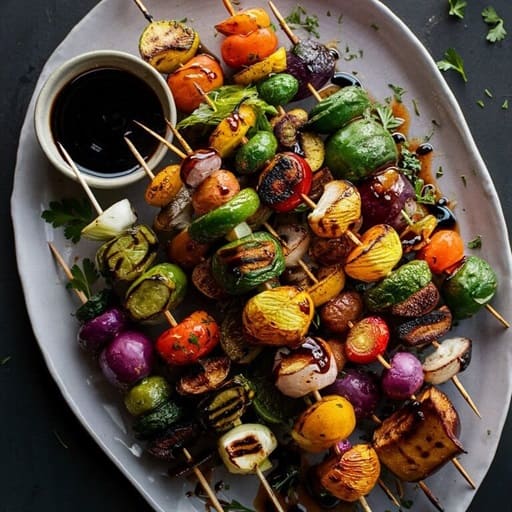Grilling isn’t just for meat lovers; it’s a versatile cooking method that can bring out the best in fresh vegetables, transforming them into a flavorful and satisfying meal. The Traeger-Grilled Veggie Skewers with Balsamic Glaze are a perfect example of how grilling can elevate the natural sweetness and texture of vegetables. Whether you’re a seasoned vegetarian or just looking to add more plant-based meals to your diet, these veggie skewers are sure to impress.
Vegetables are a must on a diet. I suggest carrot
Jim Davis
cake, zucchini bread, and pumpkin pie.
The balsamic glaze adds a tangy, slightly sweet finish that perfectly complements the smokiness from the grill. Easy to prepare, healthy, and bursting with flavor, this recipe is a must-try for your next outdoor cookout or weeknight dinner.
Table of Contents

Why You’ll Love This Traeger Grilled Veggie Skewers Recipe
Healthy and Nutritious: Packed with vitamins, minerals, and fiber, these veggie skewers are a nutritious option that doesn’t sacrifice flavor.
Perfect for All Diets: Whether you’re vegetarian, vegan, or just looking to incorporate more veggies into your meals, this recipe fits the bill.
Easy to Make: With simple preparation and quick grilling time, you can have a delicious meal on the table in no time.
Versatile: Customize the skewers with your favorite vegetables and adjust the balsamic glaze to your taste.
Impressive Presentation: The colorful array of grilled vegetables on skewers makes for a visually appealing dish that’s sure to wow your guests.

How to Make Traeger Grilled Veggie Skewers
Ingredients
- Bell peppers (variety of colors)
- Zucchini
- Cherry tomatoes
- Red onions
- Mushrooms
- Balsamic vinegar
- Honey (or maple syrup/agave for vegan)
- Salt
Detailed Instructions
Prep the Vegetables: Choose a variety of colorful vegetables like bell peppers, zucchini, cherry tomatoes, red onions, and mushrooms. Wash and cut them into uniform pieces for even grilling.
Assemble the Skewers: Thread the vegetables onto skewers, alternating types to create a visually appealing mix.
Make the Balsamic Glaze: In a small saucepan, combine balsamic vinegar, honey, and a pinch of salt. Simmer until the mixture reduces and thickens into a glaze.
Grill the Skewers: Preheat your Traeger grill to medium-high heat. Place the skewers on the grill and cook for 10-15 minutes, turning occasionally, until the vegetables are tender and slightly charred.
Glaze and Serve: Brush the grilled skewers with the balsamic glaze just before serving. Enjoy them hot off the grill or at room temperature.

Tips For Traeger Grilled Veggie Skewers
Soak Wooden Skewers: If using wooden skewers, soak them in water for at least 30 minutes before grilling to prevent them from burning.
Uniform Size: Cut vegetables into similar sizes to ensure even cooking.
Don’t Overcrowd: Leave a little space between each vegetable piece on the skewers to allow for even grilling.
Make Ahead: You can assemble the skewers and prepare the glaze ahead of time, making this recipe even quicker on the day of grilling.
Extra Glaze: Keep extra balsamic glaze on the side for drizzling over the skewers or other dishes.
To eat is a necessity, but to eat intelligently is an art.
François de La Rochefoucauld
Recipe FAQ
How long to cook vegetables on a Traeger grill?
Vegetables on a Traeger grill typically take about 10–15 minutes to cook at medium-high heat (around 350°F). Harder vegetables like carrots or potatoes may require slightly longer, while softer vegetables like zucchini or bell peppers will cook more quickly. Monitor for tender-crisp doneness with slight char marks for optimal flavor.
What temperature do you grill veggie skewers?
The ideal temperature for grilling veggie skewers is 350°F–375°F. This temperature ensures the vegetables cook evenly without burning, preserving their texture and natural sweetness.
How long does it take to smoke vegetable kabobs?
Smoking vegetable kabobs at a lower temperature, such as 225°F–250°F, takes approximately 30–40 minutes. This slower cooking process infuses the vegetables with a subtle smoky flavor. Be sure to turn the skewers halfway through for even cooking.
Can you prep veggie skewers the night before?
Yes, you can prepare veggie skewers the night before. Assemble the vegetables on skewers and store them in an airtight container in the refrigerator. Brush them lightly with olive oil to prevent drying. For added flavor, you can also marinate the vegetables overnight.
What happens if you don’t soak skewers before grilling?
Skipping the soaking step for wooden skewers can cause them to burn or catch fire on the grill. Soaking wooden skewers in water for at least 30 minutes before grilling prevents this issue and ensures safe and effective grilling.
What should I do the night before veg prep?
To streamline the process:
- Wash and cut all vegetables into uniform sizes for even cooking.
- Marinate the vegetables in olive oil, salt, pepper, and desired seasonings or sauces for enhanced flavor.
- Thread vegetables onto skewers and store them in an airtight container in the refrigerator.
Common Mistakes in Grilling Veggie Skewers
Overcrowding the Skewers
When vegetables are packed too tightly on a skewer, heat and smoke can’t circulate properly, resulting in uneven cooking. Overcrowding also prevents the glaze or seasoning from adhering to every piece.
Solution: Thread vegetables with slight gaps between each piece, ensuring even exposure to heat and smoke.
Not Cutting Uniform Pieces
Unevenly sized vegetables lead to inconsistent cooking. Smaller pieces may char or overcook, while larger pieces remain undercooked and tough.
Solution: Cut all vegetables into similar sizes, roughly 1 to 1.5 inches, for uniform cooking. For dense vegetables like carrots or sweet potatoes, slice them thinner to match the cooking time of softer vegetables.
Skipping the Soaking Step for Wooden Skewers
Wooden skewers burn or break if not soaked before grilling, potentially ruining the presentation and safety of the dish.
Solution: Soak wooden skewers in water for at least 30 minutes to an hour before threading vegetables. For an extra flavor boost, try soaking them in seasoned water or white wine.
Using the Wrong Vegetables
Some vegetables, like lettuce or overly delicate greens, are unsuitable for grilling as they wilt or burn quickly.
Solution: Choose sturdy vegetables like bell peppers, zucchini, mushrooms, cherry tomatoes, red onions, eggplant, or asparagus for grilling. These vegetables hold up well under heat and develop great flavor.
Applying Glaze or Sauce Too Early
Adding the balsamic glaze too early can lead to burning due to the sugar content in the glaze, resulting in an unpleasant bitter flavor.
Solution: Apply the glaze in the last 2–3 minutes of grilling to achieve a caramelized finish without burning.
Ignoring the Grill Temperature
Cooking skewers over high heat can scorch the outside while leaving the inside raw. Conversely, grilling on too low a heat may result in limp, undercooked vegetables.
Solution: Preheat the grill to 350°F–375°F and maintain this steady temperature throughout the cooking process.
Failing to Pre-Marinade or Season the Vegetables
Unseasoned vegetables can taste bland, even after grilling. Skipping a marinade also reduces the ability of vegetables to retain moisture during cooking.
Solution: Toss vegetables in olive oil, salt, pepper, and your favorite herbs or spices before threading them onto skewers. Marinating for at least 30 minutes enhances flavor and texture.
Overcooking the Vegetables
Leaving skewers on the grill for too long makes vegetables mushy and removes their natural crunch.
Solution: Monitor cooking time closely and remove skewers as soon as vegetables are tender-crisp with slight char marks. Most vegetables cook in 10–15 minutes.
Neglecting to Turn the Skewers
Failing to turn skewers during grilling results in uneven cooking, with one side overdone and the other undercooked.
Solution: Rotate skewers every 3–4 minutes to ensure even cooking and charring on all sides.
Conclusion for Traeger Grilled Veggie Skewers with Balsamic Glaze
Traeger-grilled veggie skewers with balsamic glaze showcase the perfect blend of smoky, charred flavors and a tangy-sweet finish. This recipe highlights the versatility of vegetables and transforms them into a vibrant, healthy dish suitable for any meal or occasion. By avoiding common mistakes such as overcrowding skewers, skipping soaking, or overcooking, you ensure perfectly grilled vegetables every time. Prepping the night before saves time and enhances flavors, making these skewers a practical and delicious choice for gatherings or weeknight dinners. Whether paired with grains, served as an appetizer, or enjoyed on their own, these veggie skewers are sure to impress with their taste and presentation.

Traeger Grilled Veggie Skewers with Balsamic Glaze
Ingredients
Equipment
Method
- o Cut vegetables into uniform pieces.
- o Thread onto skewers.
- o Prepare balsamic glaze by simmering vinegar and honey.
- o Grill skewers on medium-high heat for 10-15 minutes.
- o Brush with balsamic glaze and serve.
Nutrition
Notes
- Use a variety of vegetables for color and flavor.
- Keep a close eye on the skewers to avoid burning.
Let me know!
Did you find this post helpful? By leaving a star rating and share, it will help others find my recipes.



